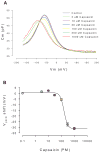Effect of capsaicin on potassium conductance and electromotility of the guinea pig outer hair cell
- PMID: 21044673
- PMCID: PMC3387680
- DOI: 10.1016/j.heares.2010.10.010
Effect of capsaicin on potassium conductance and electromotility of the guinea pig outer hair cell
Abstract
Capsaicin, the classic activator of TRPV-1 channels in primary sensory neurons, evokes nociception. Interestingly, auditory reception is also modulated by this chemical, possibly by direct actions on outer hair cells (OHCs). Surprisingly, we find two novel actions of capsaicin unrelated to TRPV-1 channels, which likely contribute to its auditory effects in vivo. First, capsaicin is a potent blocker of OHC K conductances (I(K) and I(K,n)). Second, capsaicin substantially alters OHC nonlinear capacitance, the signature of electromotility - a basis of cochlear amplification. These new findings of capsaicin have ramifications for our understanding of the pharmacological properties of OHC I(K), I(K,n) and electromotility and for interpretation of capsaicin pharmacological actions.
Copyright © 2010 Elsevier B.V. All rights reserved.
Figures







Similar articles
-
Modulation of outer hair cell electromotility by cochlear supporting cells and gap junctions.PLoS One. 2009 Nov 20;4(11):e7923. doi: 10.1371/journal.pone.0007923. PLoS One. 2009. PMID: 19936276 Free PMC article.
-
A potassium current in guinea-pig outer hair cells activated by ion channel blocker DCDPC.Neuroreport. 1998 Dec 1;9(17):3887-91. doi: 10.1097/00001756-199812010-00022. Neuroreport. 1998. PMID: 9875723
-
Outer hair cell electromotility is low-pass filtered relative to the molecular conformational changes that produce nonlinear capacitance.J Gen Physiol. 2019 Dec 2;151(12):1369-1385. doi: 10.1085/jgp.201812280. Epub 2019 Nov 1. J Gen Physiol. 2019. PMID: 31676485 Free PMC article.
-
Regulation of electromotility in the cochlear outer hair cell.J Physiol. 2006 Oct 1;576(Pt 1):43-8. doi: 10.1113/jphysiol.2006.114975. Epub 2006 Aug 3. J Physiol. 2006. PMID: 16887876 Free PMC article. Review.
-
Prestin and electromotility may serve multiple roles in cochlear outer hair cells.Hear Res. 2022 Sep 15;423:108428. doi: 10.1016/j.heares.2021.108428. Epub 2021 Dec 26. Hear Res. 2022. PMID: 34987016 Review.
Cited by
-
TRPV1: A Potential Drug Target for Treating Various Diseases.Cells. 2014 May 23;3(2):517-45. doi: 10.3390/cells3020517. Cells. 2014. PMID: 24861977 Free PMC article.
-
IR laser-induced perturbations of the voltage-dependent solute carrier protein SLC26a5.Biophys J. 2013 Oct 15;105(8):1822-8. doi: 10.1016/j.bpj.2013.09.008. Biophys J. 2013. PMID: 24138858 Free PMC article.
-
Optogenetic Control of Mouse Outer Hair Cells.Biophys J. 2016 Jan 19;110(2):493-502. doi: 10.1016/j.bpj.2015.11.3521. Biophys J. 2016. PMID: 26789771 Free PMC article.
-
Capsaicin Is a Negative Allosteric Modulator of the 5-HT3 Receptor.Front Pharmacol. 2020 Aug 31;11:1274. doi: 10.3389/fphar.2020.01274. eCollection 2020. Front Pharmacol. 2020. PMID: 32982728 Free PMC article.
-
Extracellular chloride regulation of Kv2.1, contributor to the major outward Kv current in mammalian outer hair cells.Am J Physiol Cell Physiol. 2012 Jan 1;302(1):C296-306. doi: 10.1152/ajpcell.00177.2011. Epub 2011 Sep 21. Am J Physiol Cell Physiol. 2012. PMID: 21940671 Free PMC article.
References
-
- Ashmore JF, Meech RW. Ionic basis of membrane potential in outer hair cells of guinea pig cochlea. Nature. 1986;322:368–71. - PubMed
-
- Brownell WE. Microscopic observation of cochlear hair cell motility. Scan Electron Microsc. 1984:1401–6. - PubMed
-
- Caterina MJ, Schumacher MA, Tominaga M, Rosen TA, Levine JD, Julius D. The capsaicin receptor: a heat-activated ion channel in the pain pathway. Nature. 1997;389:816–24. - PubMed
-
- Chambard JM, Ashmore JF. Regulation of the voltage-gated potassium channel KCNQ4 in the auditory pathway. Pflugers Arch. 2005;450:34–44. - PubMed
Publication types
MeSH terms
Substances
Grants and funding
- DC 010844/DC/NIDCD NIH HHS/United States
- R01 DC008130/DC/NIDCD NIH HHS/United States
- DC 000141/DC/NIDCD NIH HHS/United States
- K23 DC000141/DC/NIDCD NIH HHS/United States
- R01 DC000141/DC/NIDCD NIH HHS/United States
- R01 DC006273/DC/NIDCD NIH HHS/United States
- R01 DC000273/DC/NIDCD NIH HHS/United States
- P30 DC005983/DC/NIDCD NIH HHS/United States
- DC 008888-02S1/DC/NIDCD NIH HHS/United States
- DC 004716/DC/NIDCD NIH HHS/United States
- F32 DC000141/DC/NIDCD NIH HHS/United States
- DC 008888-02/DC/NIDCD NIH HHS/United States
- R01 DC004716/DC/NIDCD NIH HHS/United States
- DC 008130/DC/NIDCD NIH HHS/United States
- R01 DC010844/DC/NIDCD NIH HHS/United States
- DC 000273/DC/NIDCD NIH HHS/United States
- DC 005983/DC/NIDCD NIH HHS/United States
LinkOut - more resources
Full Text Sources
Medical

